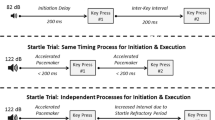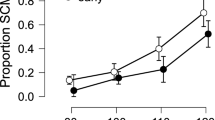Abstract
Previous studies have used a secondary probe reaction time (RT) task to assess attentional demands of a primary task. The current study used a startling acoustic stimulus (SAS) in a probe RT paradigm to test the hypothesis that attentional resources would be directly related to limitations in response preparation. Participants performed an easy or difficult version of a continuous primary task that was either primarily motor in nature (pursuit tracking) or cognitive (counting backward). Concurrently, participants responded to an auditory cue as fast as possible by performing a wrist extension secondary movement. On selected trials, the auditory cue was replaced with a SAS (120 dB), which is thought to involuntarily trigger a prepared response and thus bypass any response initiation bottleneck that may be present when trying to perform two movements. Although startle trials were performed at a shorter latency, both non-startle and startle probe trials resulted in a delayed RT, as compared to single-task trials, consistent with reduced preparation of the secondary task. In addition, analysis of SAS trial RT when a startle indicator was present versus absent provided evidence that the secondary task was at a lowered state of preparation when engaged in the cognitive primary task as compared to a motor primary task, suggesting a facilitative effect on preparatory activation when both the primary and secondary tasks are motoric in nature.




Similar content being viewed by others
Notes
Note there was a small but significant decrease in motor primary task performance on startle trials as compared to catch trials. This is likely due to the reflexive startle response temporarily interfering with the tracking task rather than any differences in attentional allocation.
References
Alibiglou L, MacKinnon CD (2012) The early release of planned movement by acoustic startle can be delayed by transcranial magnetic stimulation over motor cortex. J Physiol 590:919–936
Begeman M, Kumru H, Leenders K, Valls-Sole J (2007) Unilateral reaction time task is delayed during contralateral movements. Exp Brain Res 181:469–475
Bratzke D, Rolke B, Ulrich R (2009) The source of execution-related dual-task interference: motor bottleneck or response monitoring? J Exp Psychol Hum Percept Perform 35:1413–1426
Brown P, Rothwell JC, Thompson PD, Britton TC, Day BL, Marsden CD (1991) New observations on the normal auditory startle reflex in man. Brain 114:1891–1902
Carlsen AN, Mackinnon CD (2010) Motor preparation is modulated by the resolution of the response timing information. Brain Res 1322:38–49
Carlsen AN, Chua R, Inglis JT, Sanderson DJ, Franks IM (2004) Can prepared responses be stored subcortically? Exp Brain Res 159:301–309
Carlsen AN, Dakin CJ, Chua R, Franks IM (2007) Startle produces early response latencies that are distinct from stimulus intensity effects. Exp Brain Res 176:199–205
Carlsen AN, Chua R, Inglis JT, Sanderson DJ, Franks IM (2009) Differential effects of startle on reaction time for finger and arm movements. J Neurophysiol 101:306–314
Carlsen AN, Maslovat D, Lam MY, Chua R, Franks IM (2011) Considerations for the use of a startling acoustic stimulus in studies of motor preparation in humans. Neurosci Biobehav Rev 35:366–376
Carlsen AN, Maslovat D, Franks IM (2012) Preparation for voluntary movement in healthy and clincial populations: evidence from startle. Clin Neurophysiol 123:21–33
De Jong R (1993) Multiple bottlenecks in overlapping task performance. J Exp Psychol Hum Percept Perform 19:965–980
Drummond NM, Carlsen AN, Cressman EK (2013) Motor preparation is delayed for both directly and indirectly cued movements during an anticipation-timing task. Brain Res 1506:44–57
Drummond NM, Cressman EK, Carlsen AN (2015) Inhibition of motor-related activation during a simple reaction time task requiring visuomotor mental rotation. Behav Neurosci 129:160–169
Glencross DJ (1978) Response planning and the organization of speed movements. In: Nickerson RS (ed) Attention and performance VII. Erlbaum, Hillsdale, NJ, pp 107–125
Hanes DP, Schall JD (1996) Neural control of voluntary movement initiation. Science 274:427–430
Honeycutt CF, Kharouta M, Perreault EJ (2013) Evidence for reticulospinal contributions to coordinated finger movements in humans. J Neurophysiol 110:1476–1483
Honeycutt CF, Tresch UA, Perreault EJ (2015) Startling acoustic stimuli can evoke fast hand extension movements in stroke survivors. Clin Neurophysiol 126:160–164
Kahneman D (1973) Attention and effort. Prentice Hall, Englewood Cliffs
Keele SW (1973) Attention and human performance. Goodyear, Palisades
Kerr B (1973) Processing demands during mental operations. Mem Cogn 1:401–412
Kumru H, Urra X, Compta Y, Castellote JM, Turbau J, Valls-Solé J (2006) Excitability of subcortical motor circuits in Go/noGo and forced choice reaction time tasks. Neurosci Lett 406:66–70
Lee TD, Elliott D (1986) Probing the motor program: effects of output competition during movement preparation. Hum Mov Sci 5:173–183
MacKinnon CD, Bissig D, Chiusano J et al (2007) Preparation of anticipatory postural adjustments prior to stepping. J Neurophysiol 97:4368–4379
Maslovat D, Carlsen AN, Franks IM (2012) Subcortical motor circuit excitability during simple and choice reaction time. Behav Neurosci 126:499–503
Maslovat D, Chua R, Spencer HC, Forgaard CJ, Carlsen AN, Franks IM (2013) Evidence for a response preparation bottleneck during dual-task performance: effect of a startling acoustic stimulus on the psychological refractory period. Acta Psychol 144:481–487
Maslovat D, Carter MJ, Kennefick M, Carlsen AN (2014a) Startle neural activity is additive with normal cortical initiation-related activation. Neurosci Lett 558:164–168
Maslovat D, Klapp ST, Jagacinski RJ, Franks IM (2014b) Control of response timing occurs during the simple reaction time interval but on-line for choice reaction time. J Exp Psychol Hum Percept Perform 40:2005–2021
Maslovat D, Franks IM, Leguerrier A, Carlsen AN (2015) Responses to startling acoustic stimuli indicate that movement-related activation is constant prior to action: a replication with an alternate interpretation. Physiol Rep 3:e12300
McLeod P (1977) A dual task response modality effect: support for multiprocessor models of attention. Q J Exp Psychol 29:651–667
McLeod P (1980) What can probe RT tell us about the attentional demands of movement? In: Stelmach GE, Requin J (eds) Tutorials in motor behavior. North-Holland, Amsterdam, pp 579–589
Morey RD (2008) Confidence intervals from normalized data: a correction to Cousineau (2005). Tutor Quant Methods Psychol 4:61–64
Pashler HE (1994) Dual-task interference in simple tasks: data and theory. Psychol Bull 116:220–244
Posner MI, Keele SW (1969) Attentional demands of movement. In: Proceedings of the 16th congress of applied psychology. Swets and Zeitlinger, Amsterdam
Schafer JL, Graham JW (2002) Missing data: our view of the state of the art. Psychol Methods 7:147–177
Valls-Solé J, Rothwell JC, Goulart FR, Cossu G (1999) Patterned ballistic movements triggered by a startle in healthy humans. J Physiol 516:931–938
Valls-Solé J, Kumru H, Kofler M (2008) Interaction between startle and voluntary reactions in humans. Exp Brain Res 187:497–507
Wickens J, Hyland B, Anson G (1994) Cortical cell assemblies: a possible mechanism for motor programs. J Mot Behav 26:66–82
Woodworth RS (1938) Experimental Psychology. Holt, New York
Acknowledgments
Supported by a Natural Sciences and Engineering Research Council of Canada (NSERC) discovery grant awarded to ANC (RGPIN: 418361-2012). We would also like to acknowledge the assistance of two anonymous reviewers for their constructive comments on earlier versions of this manuscript.
Author information
Authors and Affiliations
Corresponding author
Rights and permissions
About this article
Cite this article
Maslovat, D., Drummond, N.M., Carter, M.J. et al. Reduced motor preparation during dual-task performance: evidence from startle. Exp Brain Res 233, 2673–2683 (2015). https://doi.org/10.1007/s00221-015-4340-7
Received:
Accepted:
Published:
Issue Date:
DOI: https://doi.org/10.1007/s00221-015-4340-7




